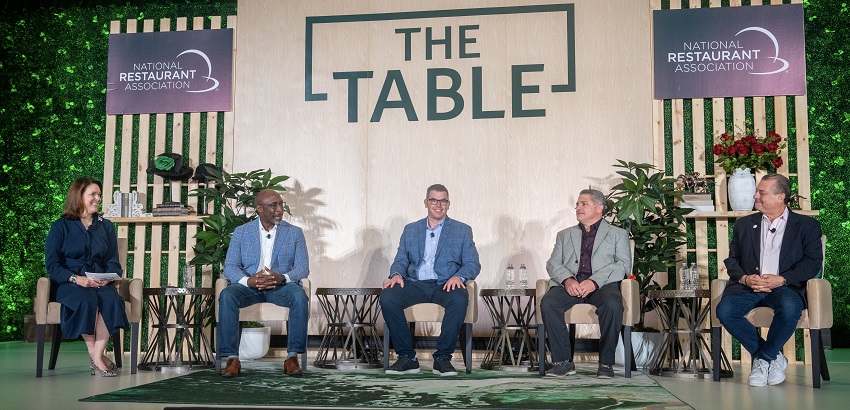Articles
September 02, 2025
Industry experts set course for restaurant technology
Execs bring their insights on AI and other tech tools to The Table.

From left, the Association’s Michelle Korsmo, Five Guys’ Zerrick Pearson, Aramark’s Ted Orman, Lehigh Valley’s Ed Kruczek, and IFBTA’s Rob Grimes talked about tech innovations.
As industry-related technology continues to evolve, executives representing several restaurant companies headlined a panel at The Table, the National Restaurant Association’s recent conference in Louisville, KY., to share ideas on how it enhances operational efficiencies.
“This business is hard,” Korsmo said. “Operators have to think about what they’re implementing in terms of improving the customer experience, the franchisee experience, and their employees’ experience. When we think about our workforce, one thing we know is they expect us to use technology to make things easier for them. Unleashing breakthrough efficiency in business is challenging, but it’s also essential to success.”
Five Guys’ Pearson explained how AI is amping up voice-ordering capabilities, especially in the quickservice space.
“Recently, in South Carolina, my entire drive-thru order experience was handled by a bot,” he said. “It performed well, and I had a great interaction with the staff at the pickup window. AI aims to improve efficiency, speed, and customer experience. It helps employees to focus on the customer, operations and the food. It’s great for our industry.”
Lehigh Valley’s Kruczek said his company, a franchisee of Red Robin and Wingstop, must rely on the technology its franchisors supply. However, he added that they can supplement those offerings to help their employees work more efficiently.
“We’re limited in what we can do,” he said. “We can’t really change it, but we can add onto it in some ways. For example, we’re creating more mobile POS stations and providing more tablets for our servers. This allows them to stay in their sections with the guests so they’re more able to meet their needs. It also allows them to take orders and send them to the kitchen immediately. That way, they don’t stack up and there’s less chance for error. It’s one way we can enhance our operations without altering technology specified by the franchisor.”
“This is going to allow us to engage with customers more easily, especially when it comes to payment, which can be challenging,” he said. “It will really enhance the dining experience.”
Adapting to a new world order
Michelle Korsmo, National Restaurant Association President & CEO, moderated the panel of top-level technology experts, which included Zerrick Pearson, CIO of Five Guys Enterprises; Ted Orman, Vice President of Technology for Aramark; Ed Kruczek, Chief Technology Officer at Lehigh Valley Restaurant Brands; and Rob Grimes, Founder & CEO of the International Food and Beverage Technology Association (IFBTA). They discussed the real-world applications, forward-looking insights, and lessons learned as their companies adapt to new technologies, like AI for kitchen automation, voice ordering, enhanced POS systems, and even labor scheduling.“This business is hard,” Korsmo said. “Operators have to think about what they’re implementing in terms of improving the customer experience, the franchisee experience, and their employees’ experience. When we think about our workforce, one thing we know is they expect us to use technology to make things easier for them. Unleashing breakthrough efficiency in business is challenging, but it’s also essential to success.”
4 ways that AI increases efficiency
The panelists talked about how AI is becoming a gamechanger in 4 specific ways:- Assisting in taking phone orders, which allows staff members to focus on other tasks, and reduces human error in the drive-thru
- Optimizing food prep and reducing food waste in the back of the house
- Managing labor to ensure optimal staffing during peak hours
- Tailoring ads and targeting marketing to individual diners that enhance engagement through customized offers that appeal to them in real time
Five Guys’ Pearson explained how AI is amping up voice-ordering capabilities, especially in the quickservice space.
“Recently, in South Carolina, my entire drive-thru order experience was handled by a bot,” he said. “It performed well, and I had a great interaction with the staff at the pickup window. AI aims to improve efficiency, speed, and customer experience. It helps employees to focus on the customer, operations and the food. It’s great for our industry.”
Lehigh Valley’s Kruczek said his company, a franchisee of Red Robin and Wingstop, must rely on the technology its franchisors supply. However, he added that they can supplement those offerings to help their employees work more efficiently.
“We’re limited in what we can do,” he said. “We can’t really change it, but we can add onto it in some ways. For example, we’re creating more mobile POS stations and providing more tablets for our servers. This allows them to stay in their sections with the guests so they’re more able to meet their needs. It also allows them to take orders and send them to the kitchen immediately. That way, they don’t stack up and there’s less chance for error. It’s one way we can enhance our operations without altering technology specified by the franchisor.”
Enhancing the dining experience
Grimes expressed excitement about more operators buying into frictionless technology, which, when used for payment and in kiosks, can speed up service and increase efficiency.“This is going to allow us to engage with customers more easily, especially when it comes to payment, which can be challenging,” he said. “It will really enhance the dining experience.”
Sign up for our Newsletter
The latest news from the National Restaurant Association, published every other Thursday
By clicking Submit I agree to receive email communications from the National Restaurant Association and agree to our Privacy Policy(Opens in a new window).